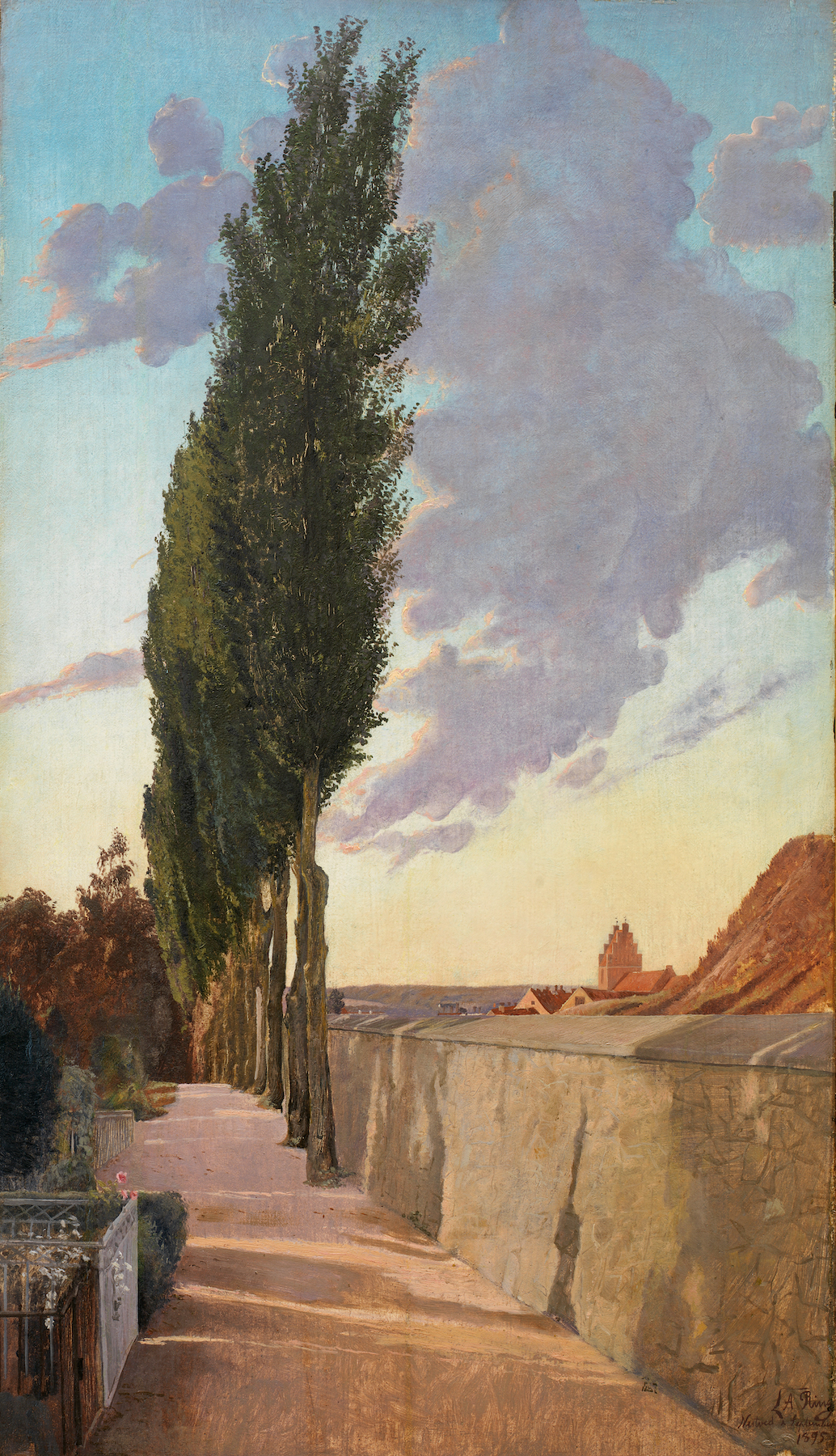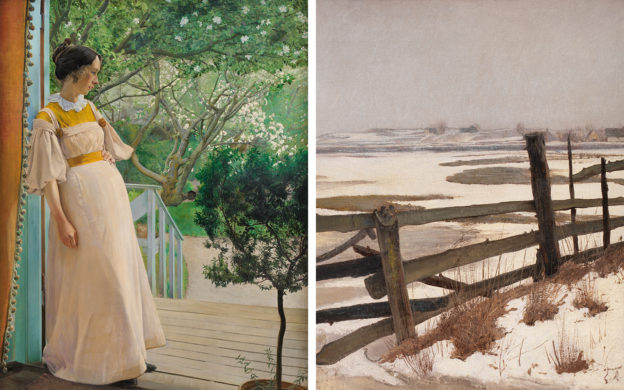| In partnership with |  |
“L.A. Ring is the Danish artist most capable of expressing the mental and physical changes that took place in Denmark at the turn of the 20th century,” Peter Norgaard Larsen explains. Senior Curator at Statens Museum for Kunst (the Danish National Gallery), Larsen is a foremost expert on Laurits Andersen Ring, better known as L.A. Ring, the prolific painter who, with quiet brilliance, captured the landscape and atmosphere of Denmark on the brink of industrial revolution.
Ring, similiar to Vilhelm Hammershøi, is extremely well known in Denmark, but lesser known internationally. Unlike Hammershøi, who was a contemporary and friend, L.A. Ring hasn’t had the re-emergence on the art scene that’s made Hammershøi a major name globally. That may be about to change, thanks to a United States exhibition, “On the Edge of the World: Masterworks by Laurits Andersen Ring from SMK,” that starts at the National Nordic Museum of Seattle from 14th September 2019 – 19th January in 2020 then ends at the Bruce Museum in Greenwich, Connecticut from 1st February – 24th May 2020.
The exhibition is organized by Statens Museum for Kunst in collaboration with American Friends of Statens Museum for Kunst (AFSMK), an organization that brings Danes and Americans together to support Danish art.

L.A. Ring, Når toget ventes. Jernbaneoverkørsel ved Roskilde Landevej / Waiting for the Train. Level Crossing by Roskilde Highway, 1914
So what makes Ring worthy of his place among the great Danish artists? “Ring’s blend of naturalism and symbolism speaks to the viewer, even today,” Larsen says. “He has this incredible eye for peculiar motives; for what is just out of the frame.” Indeed, many of Ring’s paintings feature an item that is only partially in view; the rest is created in the viewer’s mind, understood as just out of reach of the painting. It’s almost photographic in it’s framing, giving a strange realism to his work.
But perhaps more importantly, Ring’s work speaks to a very specific Danish experience: rural life at the end of the 19th and beginning of the 20th centuries. “If you compare his work to, for example, Grant Wood or Winslow Homer, he very much falls into that camp of ‘stick with what you know.’ Ring grew up in rural Denmark, in a small village called Ring, and that life was what he came back to again and again. It was what he knew and what inspired him,” says Larsen.
He continues, “He paints rural people with great respect, and even when he became very popular and wealthy, those were the people he felt most comfortable around. Interestingly, people think of Ring as a figure painter, but actually 70% of his work is landscape painting. In a way, it’s another figure – the landscape as self portrait.”
 |  |
Left: L.A. Ring, Er regnen hørt op? / Has it Stopped Raining? 1922; Right: L.A. Ring, Landskab med popler / Landscape with Poplars. September Evening, 1895.
But lest you think that Ring romanticized rural life, Larsen says that the artist’s views were surprisingly ambivalent. “There’s very little judgement in Ring’s work in terms of rural life versus industrialization. He comes from a place of meaning but not nostalgia, and I think that’s important to note. Politically, Ring was a revolutionary as a young man.
In the mid-1880s, he was part of a revolutionary group called ‘The Rifle Movement’ that tried to foment rebellion against the government, as Prime Minsister Estrup had essentially bypassed democracy at that point. Ring passionately believed that the lower classes deserved better treatment and walked around with a gun in his pocket, just waiting for the revolution to start. It never did.”

L.A. Ring, Et besøg i et skomagerværksted / A Visit to the Shoemaker’s Shop, 1885
Instead of leading the revolution as planned, Ring fell into a deep depression, which is reflected in his work at the time. “Ring suffered from severe depression throughout his life, and it’s evident in his work. He also experienced heartbreak, falling in love with his best friend’s wife – an unrequited love,” explains Larsen.
“Other tragedies that had a major affect were the death of his father and the physical loss of his family home, which was torn down. He was sensitive. There’s a lot of loneliness and death in his paintings in the earlier years.”

L.A. Ring, Tre dødningehoveder fra Convento dei Cappucini ved Palermo / Three Skulls from Convento dei Cappucini at Palermo, 1894
In the 1890s, Ring, then 42, met Sigrid Kähler, daughter of Kähler ceramics company founder Herman A. Kähler. She was only 21 and modelled for his paintings. They fell in love and married in 1896, had three children and moved around from Karrebæksminde to Frederiksværk to Baldersbrønde before finally settling in Roskilde, where Ring built an beautiful, modern home for his family that included a top-of-the-line heating system.
Larsen points out that this highlights Ring’s lack of animus towards industrialization; he saw both the good and bad in technology, and simply documented the space in between.

L.A. Ring, Lampelys. Interiør med kunstnerens hustru / The Artist’s Wife by Lamplight, 1898
In 1900, Ring painted what is widely considered his masterpiece, “Summer Day by Roskilde Fjord.” This work is so important to Danish culture that is included in the Danish Culture Canon, 108 works of cultural significance.

L.A. Ring, I Høst / Harvest 1885
L.A. Ring’s star continued to rise in the art world and by 1913 he was a pillar of the Danish art world. He received awards, was commissioned for public works, and became wealthy. By almost any measure, he was a total success as an artist.
Sigrid died of cancer in 1923, after which time Ring stopped painting for a couple of years. He died in 1933 at the age of 79 and has ever since remained an important figure in Danish painting. His motifs, including door or window thresholds, death, roads, and expansive landscapes, are deceptively simple in their execution but rich in meaning. Paintings such as “Harvest” (1885), capturing his brother Ole harvesting wheat in a field, are both Earthbound and ethereal, dripping with symbolism yet full of familiar physicality.

L.A. Ring, Vej ved Vinderød / A Road near Vinderød, Zealand, 1898
“Of course it’s important to get into the meaning,” Larsen says, “but let’s not forget Ring’s virtuosity as a painter. His landscapes are masterful. The man really knows how to paint snow!”
L.A. Ring’s work is primed for rediscovery. His work is Danish in its subject matter but international in scope, giving insight into Danish (and Scandinavian) culture, while remaining relevant across borders. It’s a peek into a very specific time period for Denmark; a period that was pivotal in shaping the modern country, yet is largely forgotten in favor of the mid-21st century.

L.A. Ring, Tøbrud / Thaw, 1901
His work might speak to another time, but his motivations are timeless, Larsen explains: “Ring painted because to him, the world was chaos, and painting allowed him to become the master of his universe. That is, in part, what his unconventional framing is all about. He gets to decide what’s in the picture, and what falls outside of it. For just a moment in time, he can control his own world. Who can’t relate to that?”
Find out more about “On the Edge of the World: Masterworks by Laurits Andersen Ring from SMK” in the United States:
National Nordic Museum2655 NW Market St 14th September 2019 – 19th January 2020 | Bruce Museum1 Museum Dr 1st February – 24th May 2020 |
Header image: L.A. Ring, I havedøren / At the French Windows, The Artist’s Wife, 1897. Right: L.A. Ring, Tøbrud / Thaw, 1901
Read more about AFSMK and become a member.

